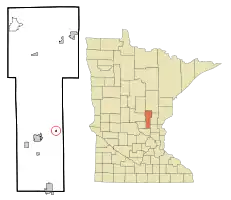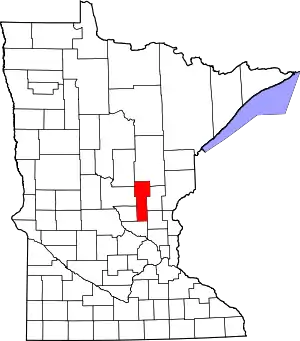Bock, Minnesota
Bock is a city in Mille Lacs County, Minnesota, United States. The population was 106 at the 2010 census.[6]
Bock | |
|---|---|
| Motto(s): Seven Meters Closer to God than Milaca | |
 Location of Bock, Minnesota | |
| Coordinates: 45°47′9″N 93°33′12″W | |
| Country | United States |
| State | Minnesota |
| County | Mille Lacs |
| Government | |
| • Mayor | Michael Petrick |
| Area | |
| • Total | 0.17 sq mi (0.43 km2) |
| • Land | 0.17 sq mi (0.43 km2) |
| • Water | 0.00 sq mi (0.00 km2) |
| Elevation | 1,102 ft (336 m) |
| Population | |
| • Total | 106 |
| • Estimate (2019)[3] | 107 |
| • Density | 640.72/sq mi (246.84/km2) |
| Time zone | UTC-6 (Central (CST)) |
| • Summer (DST) | UTC-5 (CDT) |
| ZIP code | 56313 |
| Area code(s) | 320 |
| FIPS code | 27-06814[4] |
| GNIS feature ID | 0640319[5] |
History
A post office called Bock was established in 1892.[7] Bock was named by railroad officials.[8]
Geography
According to the United States Census Bureau, the city has a total area of 0.15 square miles (0.39 km2), all land.[9]
Minnesota Highway 23 serves as a main route in the community.
Demographics
| Historical population | |||
|---|---|---|---|
| Census | Pop. | %± | |
| 1930 | 109 | — | |
| 1940 | 125 | 14.7% | |
| 1950 | 96 | −23.2% | |
| 1960 | 91 | −5.2% | |
| 1970 | 105 | 15.4% | |
| 1980 | 105 | 0.0% | |
| 1990 | 115 | 9.5% | |
| 2000 | 106 | −7.8% | |
| 2010 | 106 | 0.0% | |
| 2019 (est.) | 107 | [3] | 0.9% |
| U.S. Decennial Census[10] | |||
2010 census
As of the census[2] of 2010, there were 106 people, 46 households, and 28 families residing in the city. The population density was 706.7 inhabitants per square mile (272.9/km2). There were 49 housing units at an average density of 326.7 per square mile (126.1/km2). The racial makeup of the city was 96.2% White, 1.9% Asian, 0.9% from other races, and 0.9% from two or more races. Hispanic or Latino of any race were 1.9% of the population.
There were 46 households, of which 28.3% had children under the age of 18 living with them, 43.5% were married couples living together, 10.9% had a female householder with no husband present, 6.5% had a male householder with no wife present, and 39.1% were non-families. 30.4% of all households were made up of individuals, and 10.8% had someone living alone who was 65 years of age or older. The average household size was 2.30 and the average family size was 2.75.
The median age in the city was 44.3 years. 21.7% of residents were under the age of 18; 10.4% were between the ages of 18 and 24; 19.8% were from 25 to 44; 38.6% were from 45 to 64; and 9.4% were 65 years of age or older. The gender makeup of the city was 52.8% male and 47.2% female.
2000 census
As of the census[4] of 2000, there were 106 people, 46 households, and 31 families residing in the city. The population density was 806.2 people per square mile (314.8/km2). There were 48 housing units at an average density of 365.1 per square mile (142.6/km2). The racial makeup of the city was 99.06% White, 0.94% from other races. Hispanic or Latino of any race were 2.83% of the population.
There were 46 households, out of which 23.9% had children under the age of 18 living with them, 50.0% were married couples living together, 8.7% had a female householder with no husband present, and 32.6% were non-families. 28.3% of all households were made up of individuals, and 13.0% had someone living alone who was 65 years of age or older. The average household size was 2.22 and the average family size was 2.68.
In the city, the population was spread out, with 17.9% under the age of 18, 10.4% from 18 to 24, 25.5% from 25 to 44, 28.3% from 45 to 64, and 17.9% who were 65 years of age or older. The median age was 44 years. For every 100 females, there were 125.5 males. For every 100 females age 18 and over, there were 117.5 males.
The median income for a household in the city was $31,250, and the median income for a family was $38,750. Males had a median income of $41,250 versus $21,250 for females. The per capita income for the city was $14,806. There were 6.1% of families and 9.3% of the population living below the poverty line, including 21.1% of under eighteens and 13.0% of those over 64.
References
- "2019 U.S. Gazetteer Files". United States Census Bureau. Retrieved July 26, 2020.
- "U.S. Census website". United States Census Bureau. Retrieved 2012-11-13.
- "Population and Housing Unit Estimates". United States Census Bureau. May 24, 2020. Retrieved May 27, 2020.
- "U.S. Census website". United States Census Bureau. Retrieved 2008-01-31.
- "US Board on Geographic Names". United States Geological Survey. 2007-10-25. Retrieved 2008-01-31.
- "2010 Census Redistricting Data (Public Law 94-171) Summary File". American FactFinder. U.S. Census Bureau, 2010 Census. Retrieved 23 April 2011.
- Upham, Warren (1920). Minnesota Geographic Names: Their Origin and Historic Significance. Minnesota Historical Society. p. 343.
- Upham, Warren (1920). Minnesota Geographic Names: Their Origin and Historic Significance. Minnesota Historical Society. p. 344.
- "US Gazetteer files 2010". United States Census Bureau. Archived from the original on 2012-01-25. Retrieved 2012-11-13.
- "Census of Population and Housing". Census.gov. Retrieved June 4, 2015.
